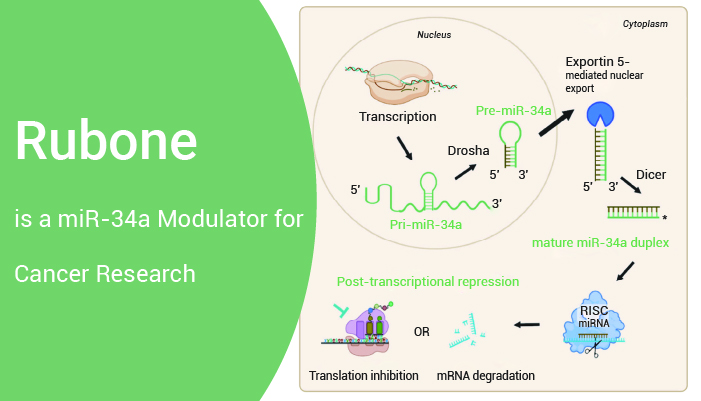MicroRNAs (miRNAs) are a class of short noncoding RNAs that negatively regulate gene expression. In addition, more than 2,500 mature miRNAs in the human genome and miRNAs can regulate approximately 25%-70% of human genes. Moreover, in cancer cells, miRNAs might function as oncogenes or tumor suppressors and their roles are manifested in almost all aspects of cancer biology including proliferation, apoptosis, invasion/metastasis, and angiogenesis. Therefore, miRNAs are ideal targets for anticancer drug development. MicroRNA-34a (miR-34a) functions as a tumor suppressor. However, miRNAs downregulates or silences in a variety of human cancers. Thus, restoration of miR-34a might represent a potential therapeutic approach for such cancers. Hence, we will introduce a miR-34a modulator-Rubone.

Rubone, a chalcone analog, is a modulator of miR-34a.
In vitro, Rubone (0-60 μM) exhibits significantly high cytotoxicity in DU145-TXR and PC3-TXR cells, suggesting that Rubone has stronger anticancer effect in advanced prostate cancer cells, which has lower miR-34a expression. Besides, Rubone (5, 10 uM; 48 h) significantly reverses the expression of miR-34a downstream gene targets of DU145-TXR and PC3-TXR cell lines. Moreover, Rubone (5, 10 uM; 48 h) upregulates miR-34a in PTX-resistant DU145-TXR and PC3-TXR cell lines in a dose dependent manner.
In vivo, Rubone monotherapy (20 mg/kg loaded PEG-PCD micelles; i.v. for five doses every other day) or combination therapy with PTX (10 mg/kg for each drug loaded PEG-PCD micelles) significantly upregulates miR-34a expression in tumor. Notably, Rubone lacks growth inhibitory effects on non-tumorigenic human hepatocytes. In addition, when in a mouse xenograft model of HCC, Rubone dramatically inhibits tumor growth, exhibiting stronger anti-HCC activity than sorafenib both in vitro and in vivo.
All in all, Rubone is a miR-34a modulator for cancer research.
Reference:
[1] Wen D, et al. Cancer Res. 2017 Jun 15;77(12):3244-3254.
[2] Zhang L, et al. J Exp Clin Cancer Res. 2019 Feb 4;38(1):53.
[3] Xiao Z, et al. Mol Cell Oncol. 2015 Feb 24;2(1):e977160.